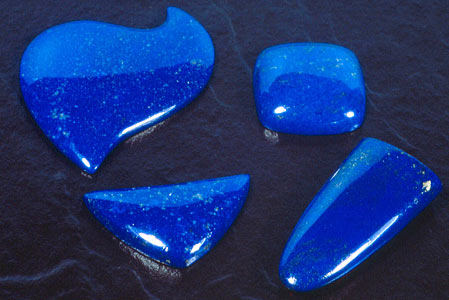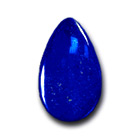 FREE SHIPPING on US orders over $150. Need help? Contact Us
FREE SHIPPING on US orders over $150. Need help? Contact Us Genuine Lapis Lazuli Gemstone

Lapis Lazuli (Pronunciation: \'lap-əs-"la-zə-lē, -"la-zhə-\)
Lapis is a gemstone straight out of fairy tales of the Arabian Nights: deepest blue with golden shining Pyrite inclusions which twinkle like little stars.
This opaque, deep blue gemstone looks back at a long history. It was one of the first stones ever to be used and worn for jewellery. Excavations in the antique cultural centres all around the Mediterranean provided archeologists with samples for jewellery which was left in tombs to accompany the deceased into the hereafter. Again and again this jewellery consisted of necklaces and objects crafted from Lapis lazuli – the clear indication that thousands of years ago the people in Mesopotamia, Egypt, Persia, Greece and Rome cherished deep blue Lapis lazuli. It is reported that at the legendary city of Ur situated on the Euphrat river, there was a busy trade in Lapis lazuli as early as four thousand years BC. In those days the stones were mined in the famous occurrences in Afghanistan. But in other cultures Lapis lazuli was also worshipped as a holy stone. Especially in the oriental countries it was considered as a gemstone with magical powers. Numerous seals, rings, scarabs and objects were crafted from the blue stone, which was introduced to Europe by Alexander the Great. Here the colour was called „ultramarine“, meaning „from beyond the seas“.
 Most expensive blue of all times
Most expensive blue of all times
The evocative name is a compound of „lapis“, the Latin word for stone, and the Arabian word „azul“, denoting the colour blue. So it is basically just a blue stone – but what a special blue! The value of this colour for the world of art was for example enormous: in fact the ultramarine blue paint used by the Grand Old Masters was nothing else but pulverised Lapis lazuli. It was pulverised and added to a mixture of binding agents, thus turning the marble-like gemstone into a bright blue paint, suitable for watercolours, tempera and oil paintings. Before it became possible in 1834 to manufacture this colour also artificially, the only kind of valuable ultramarine in the market had to be made from real Lapis lazuli, which still displays its splendour in many works of art. For example, many portraits of the Virgin Mary would have been impossible to create without Lapis lazuli blue. However, even in those days ultramarine blue was not only considered fine and rare and so powerful that it dulled all other colours, it was also very expensive indeed. But contrary to all other material employed to create the colour blue, Lapis lazuli has not lost anything of its brilliance, while other compositions have long since paled. Currently the blue pigment derived from Lapis lazuli is still applied especially for renovations, restorations and for those who love historical colours.
Stone of friendship and truth
For many people all over the world Lapis lazuli is considered a stone of truth and friendship. The blue stone is reputed to bring about harmony in relationships and to help ist wearer being an authentic individual who may openly state his or her opinion.
Lapis lazuli is an opaque stone consisting mainly of Diopside and Lasurite. It was created millions of years ago in the course of metamorphosis process turning chalk into marble stone. When unpolished, Lapis lazuli seems dull and dark blue, often with golden inclusions and whitish veins from marble. Contrary to former theories, however, the small twinkling and shining inclusions which lend the stone the attractive appeal of a star-spangled sky, are not gold but Pyrite, i.e., they are caused by iron. The blue colour, on the other hand, is caused by the sulfuric contents of Lasurite, and may result in purest ultramarine to pale blue shades. In comparison to other gemstones, the hardness is not too high and amounts to something between 5 and 6 on the Mohs’ scale.
When the cutter inhales the stone …
Many a cutter will make a face when cutting Lapis lazuli, because as soon as the stone comes into contact with the cutting wheel, it will emanate a typical, slightly foul smell. An experienced cutter will thus recognise from the smell alone the satiation of colour shown by the stone. When polishing the stone it must be treated gently and without too much pressure due to its low hardness. But no need to worry: a Lapis lazuli which has dulled because of having been worn too often may be easily polished up. Lapis lazuli is often surface sealed with colourless wax or synthetic resin. As long as no colour is added during this procedure, the sealing only serves to improve the resistance of the stone against wearing. Still, it should definitely be protected from contact with acid substances or from extravagant exposure to sunlight.
Just like over 50,000 years ago, the best rough stones are still mined in the rough Hindukush Mountains of Afghanistan. Forcefully extracted from the rocks, the blue stone nodes are transported on donkeys from the rough mountain ranges in Northeast Afghanistan down to the valleys in the summer months. Other occurrences have been provided by Nature in Russia, west of Lake Baikal, and in the Andes in Chile, where the blue stones are often veined with white or grey chalk. Lapis lazuli is also found in smaller amounts in Italy, Mongolia, the USA and Canada, in Myanmar and in Pakistan. In really good qualities, however, it is rare everywhere. Lapis lazuli jewellery is therefore available in widely differing price ranges, from luxurious to affordable. The price demanded for the gemstone depends mainly on the stone’s beauty and intensity of colour. The most favoured colour is a deep and intensive blue. Women with a fair complexion, however, often prefer the lighter blues. Finely distributed crystals resemblimg glimmer, from golden Pyrite, will increase the value of the gemstone, while an irregular, pronounced or spotty patterning will reduce it.
Lapis lazuli is a highly appreciated stone suitable for many purposes, which shows remarkable stability ion the light of quickly changing fashion trends. This is not too surprising, after all, its fairy-tale colour and its golden Pyrite light reflections have been fascinating men and women for thousands of years.



